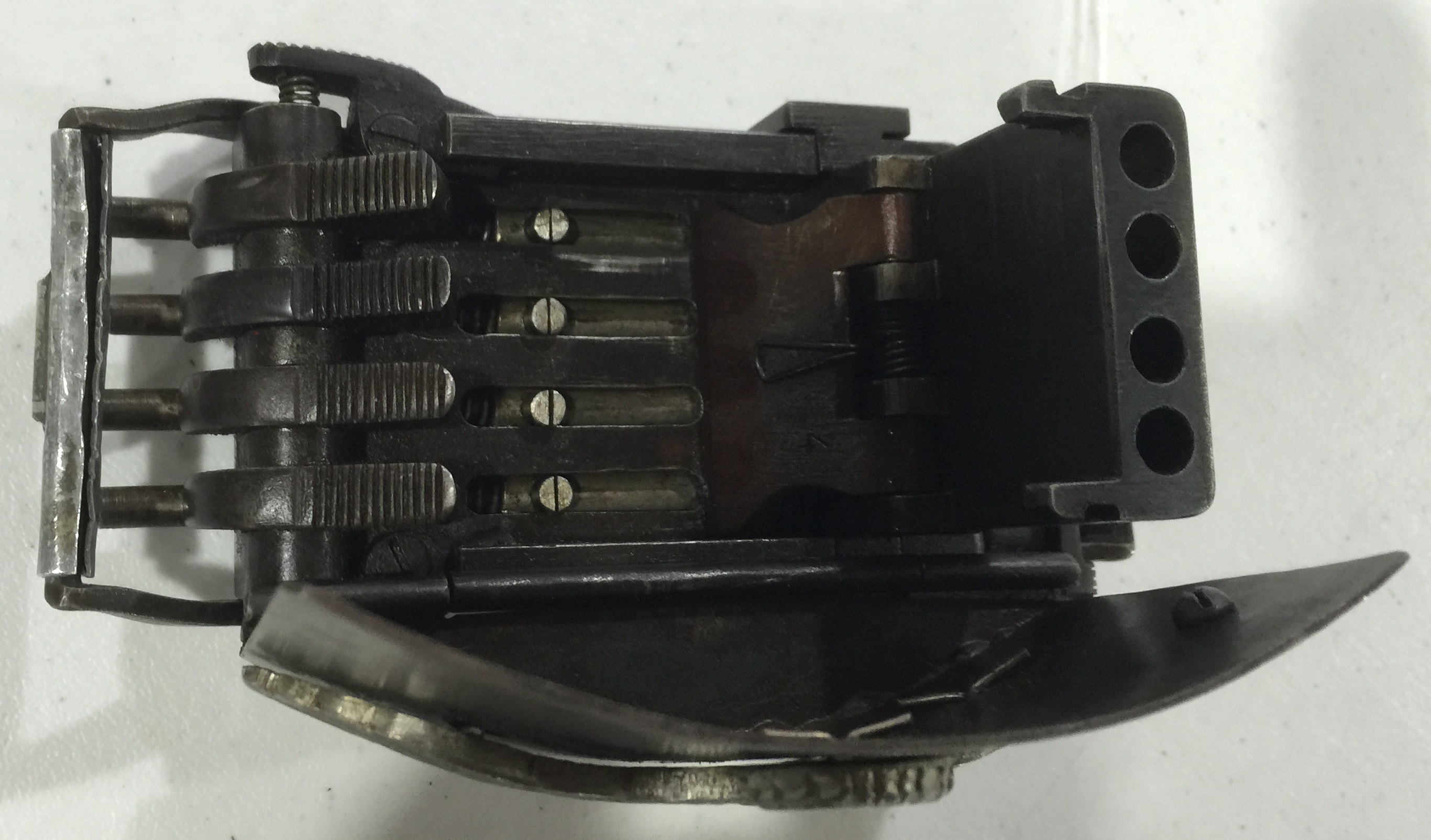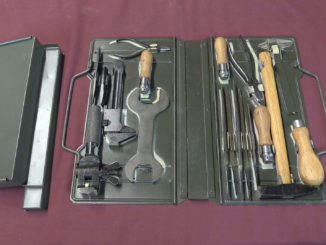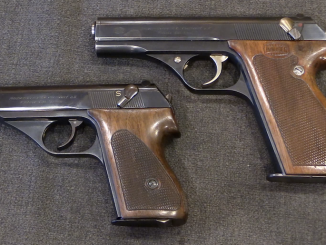Paul Mauser was very persistent – if ultimately unsuccessful – in his long-tim goal to create a practical semiautomatic rifle using a full-power cartridge. In total he tried some 17 different designs, including one in 1901 which suffered a burst casing during test firing and cost him an eye.
This particular rifle came just shortly thereafter, and uses a quite strong and safe long recoil action coupled with a 2-lug rotating bolt. Long recoil designs are fairly unusual in firearms, and this one has an interesting feature of a bolt handle which disconnects the barrel recoil spring when used (rather like Mauser’s Gewehr 41(M) rifle, in fact).
The design reportedly had persistent problems with extraction and ejecting, unfortunately, and Mauser would drop it for other designs. At some point after its testing was finished, this rifle was sporterized with a cut-down stock and express-style sights (it was originally made in full military configuration). While unfortunate, that does not change the fact that it is an extremely rare example of a Mauser experimental rifle.




Another Great Video! Thank you for giving a demonstration of this action.
When do you think the rifle was sporterized? From the video and photos, it looks like it was done post World War II.
Ian, you should buy the gun and let it accurately rebuild to its original state. 🙂
Can’t remember which of our regulars it was who pointed out that Bubba knows no borders, and no gun is ever safe from his misguided enthusiasm.
I gave a pile of American “gunsmithing” books away a few months back, they described how to butcher the life and personality out of unsuspecting old rifles, using household DIY tools… Perhaps I should have burned them.
Rant over, once a gun has been mutilated, that becomes part of its history, just like every dent, scrape and rust pit.
Just in passing, firstly I would like to says that I enjoy your presentations very much.
I have been interested in firearms for quite a long time. What I find most interesting in
your approch,is the way you handle the various firearms, SAFELY.
I would venture to say that the sporterizing of this rare rifle puts me in mind of Autrian or Bavarian hunting rifles of the pre WW II era. I`m only guessing, but I have handled a Manlicher Schrauener
with the same style of stock and finish, including the schnabel ended forestock. The caliber was in 6,5 X 54 mm, stripper clip loaded. A Spitalky rotary magazine with a removable floor plate. It also had a three leaf cape style rear sigth. The rifle was in a hard sided traveling case. With the name of a reputable London gunmaker label embosses on a brass plate affixed to the inner cover. The case also contained tools, spare stripper clips and two boxes of Eley 6,5 X 54mm amunition. Too bad I was not rich enough to purchase this gem. The bill of sale was dated,July, 1936.
Jean Roland Tremblay
p.s. Excuse my poor English
Not likely, and not provable, but how cool would it be to have a rifle personally owned and sporterized by P. Mauser?
Apparently I can’t seem to comment on this piece… Is there some software issue? I don’t see my posts showing up when I click on the “post comment” button. Time is 4:58 EST…
Okay, one post was found…
For the design that cost Paul Mauser his eye, one should search the James Julia auction site for a “C98 rifle.”
While it is regrettable that many now-collectable weapons were “sporterized” after both wars, and especially WWII, one must remember that there had been almost NO sporting rifles manufactured for almost five years and no prospect for one being available at a reasonable price for several more. So if a returning veteran wanted to resume, or even assume, hunting there was an almost inexhaustible supply of “liberated” weapons available. And a rifle made to kill men is almost the exact one you need to kill a deer. So, being a child of that era, I was MANY Mousers and other military weapons that suffered the indignity of alteration. In fact, I have a few myself and was guilty of having these alterations done or did them myself. The major difference is that I was usually better qualified than most. For many years the best basis for a new hunting rifle began with a Mauser 98 action and a mail-order stock. I have seen many Arisaka Type 99s re-chambered for a .30-06 case with a 7.7mm/.311 bullet. But back then none of us foresaw the collectability of these weapons. As an example, I have a Type 99 Sniper without the scope that I paid $5.00 for in 1962. I saw one in a gunshop last spring in worse shape than mine priced at $485.00. A “sporterized” standard Type 99 in the same shop was priced at $358.00. Back in 1962 my fellow gun club members told me I had been cheated at $5.00. But on another note, not 10 miles from my home there is a 7mm custom built Mauser made in Germany that is heavily engraved and scribed as a presentation rifle to one “A Krupp” (Alfried Krupp von Bohlen und Halbach) that was “liberated” at the end of the war but has remained unaltered but often fired sine being brought home by the grandfather of the present owner. But as for all the ones that were altered, many fed families who could not have hunted otherwise.
I dislike sporterized military arms because the modifications, while pleasant to view, generally are done without regards to user safety or product integrity.
But I would have to give “Bubba” a pat on the back if it turned out that the original stock and barrel shroud were almost totally deteriorated. Originally the front sight of the 1902 Mauser prototype would have been on the shroud, and the shroud would have attracted moisture (a problem usually associated with Belgian Mauser rifles and the Gewehr 88). The original stock probably had rotted away by the time “Bubba” resorted to giving the rifle a new stock with a semi-pistol grip. With this in mind, one should therefore assume that the guy sporterizing the rifle had no knowledge of military style stocks or could not create one without attracting unwanted attention from the ATF.
You can find the patent drawings for both rifles on Google! TRUST ME!!!!!!!!
Oops, forgot some content! The last line in the previous post refers to the patents for the 1898 Short-Recoil Mauser Selbstladegewehr and the 1902 long-recoil model…
Most of my “sporterized” conversions’ metal work was by P. O. Ackley or W. H. Womack (riflesmith in Shreveport, Louisiana). This “Bubba’s” part was to make custom rifle stocks for my rifles as well as some for custom rifles for customers for Mr. Womack … especially thumb-hole stocks and reproductions of older rifles. We were close enough that when his son was killed in Viet Nam Mr. Walter gave me the .50 cal. aircraft barrel he was converting to a muzzleloader for him to use on a brown bear hunt to Alaska when he came back. I still have it, as given, in my gun safe and it will never be finished or altered as long as I or my grandson live. He stamped it with his “W. H. Womack, Riflesmith” stamp he used on all his custom guns back in the 1960s just before he handed ti to me on our last visit.
I pray that the barrel stay as it is until a person worthy of finishing the product comes of age…
That was no “Bubba” that restocked that rifle. Bordereless checkering, super wood, nice lines, cheak piece, fit and finish is immaculate. Who ever did the work was a very skilled.
As I said, the original stock probably didn’t come out of World War II looking usable…